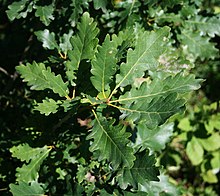|
Quercus petraea subsp. polycarpa
Quercus petraea subsp. polycarpa, synonyms including Quercus iberica,[2] is a deciduous tree native from Austria to Iran. Its range includes the Caucasus, where it may be called the Georgian oak.[3] DescriptionQuercus petraea subsp. polycarpa is a fairly large tree growing up to 20–25 metres (66–82 ft) in height, or exceptionally up to 40 m (130 ft). It is known for its very short stalk and acorns that occur either in pairs or alone.[3] DistributionQuercus petraea subsp. polycarpa is native to eastern Europe from Austria to European Turkey, including Bulgaria, Czechoslovakia, Greece, Hungary, Romania, former Yugoslavia and the Caucasus (including Armenia, Azerbaijan and Georgia) and temperate asia including Turkey and Iran.[1] In Georgia, the tree is widely distributed throughout the drier regions of eastern Georgia and generally does not like excessively moist or marshy soils, although it can be found in large groves in moist areas of western Georgia as well. It forms forests together with chestnut, hornbeam and maple. In most areas, it grows at elevations of 400–1,000 m (1,300–3,300 ft) above sea level, but in some cases it can be found at elevations up to 1,500–2,000 m (4,900–6,600 ft) above sea level.[3] References
|
||||||||||||||||||||||||||||||||||||
